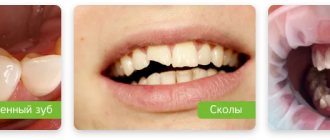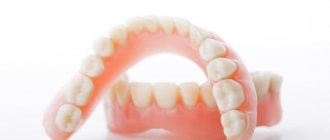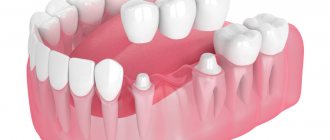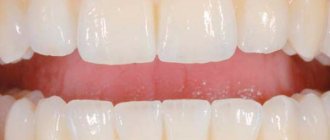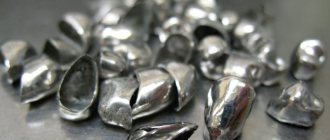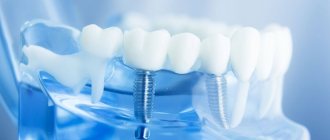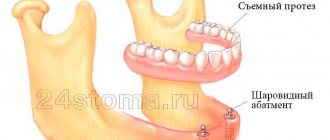Sooner or later, every person is faced with the need to install crowns or dentures. There is a myth that for this you need to grind down healthy teeth in the neighborhood. In fact, this is not the case; only a damaged tooth can be ground, onto which a crown is placed in the form of a cap made of plastic, metal, porcelain, metal-ceramics and other materials and their combinations. The reliability and durability of a crown depends not only on the quality of the materials of its components, but also on production technology, the skill of dentists and orthopedists taking part in its manufacture.
{reviews}
A crown on a tooth is used both for the reconstruction of a damaged tooth and as a support for a bridge and other functions (dentition correction). Different types of crowns have their own advantages and disadvantages. Stamped and plastic structures used to be very popular. Let's consider their features.
{sales}
Stamped crowns in Stavropol
Stamped crowns are one of the cheapest, due to the simple manufacturing technology and inexpensive material used for stamping, usually stainless metal alloys. The production process of stamped crowns is outdated and has many disadvantages, which affects the patient’s health:
- A stamped crown is not functional; it is not able to reproduce the anatomical features of the tooth, which is why it is only 50% effective when chewing.
- Stamping does not provide a good fit to the ground tooth; as a result, food debris penetrates into the gap between the tooth and the crown and the destructive process continues, which causes inconvenience to the patient in the form of an unpleasant odor, the need to remove the crown, treat the tooth and perform re-prosthetics.
- Over time, the teeth under the crown are destroyed, and the entire structure depressurizes; the manufacturing technology of stamped crowns and bridges is to blame for this.
- The layer of metal in such crowns is too thin and tends to wear out during use. Therefore, stamped structures are short-lived.
- Stamped crowns are highly susceptible to corrosion and create galvanism in the oral cavity, which causes an unpleasant taste in the mouth, a burning sensation on the tongue and intoxication of the entire body.
- This type of crown is not aesthetically pleasing. And the use of the previously popular technique of “gilding” such crowns by spraying a titanium nitride compound is also harmful to health. Therefore, it is better to choose another type of crowns if you want them to last a long time and the teeth under them not to deteriorate.
{works}
Metal-plastic
They differ from metal-ceramic ones at a more affordable cost. At the base of the crown there is usually an inexpensive metal: stainless medical steel or an alloy based on it. The coating is some kind of polymer: plastic or acrylic. It is white in color, but its shine is slightly different from enamel. However, when the crown is deep in the mouth, it is not noticeable.
The disadvantages of such crowns are:
- Low strength - they cannot be chewed on something hard, they wear out quickly, and therefore are most often used as a temporary masking of a defect while a permanent prosthesis is being prepared.
- Also, the polymer may darken when exposed to any coloring substances (food coloring).
- In some patients, the polymer causes swelling and irritation of the gums.
- The likelihood of allergies is higher than when using other types of structures.
Plastic crowns in Stavropol
Dental crowns made of acrylic plastic initially have an aesthetic appearance, but this advantage over stamped products is lost over time. Within a year or even less, the pleasant color of the plastic crowns, close to the natural shade of the teeth, changes: it darkens and becomes covered with stains. The hygienic qualities of plastic crowns are also not up to par, they are not particularly hard, and the structure of the plastic is porous.
Among the new products in the field of dental prosthetics are reinforced plastic crowns made of photopolymers; they are quite advertised. But theoretically, the strength of such structures has not been proven, and in practice, the tooth has to be heavily ground under a crown made of any type of plastic, otherwise it can quickly crack.
In addition, plastic does not have biological compatibility with the gums, which is fraught with inflammation and the appearance of a characteristic dark rim at the point of contact of the gums with the crown.
{steps}
Ceramic crowns for front teeth
Many experts believe that ceramic dental crowns can only be used for prosthetics of the front teeth. Meanwhile, new generation pressed ceramics make it possible to make not only highly aesthetic, but also highly durable structures. The absence of a metal frame in such prostheses is not a sign of fragility or unreliability. Ceramic crowns for chewing teeth also have a place in dental practice.
Solid crowns in Stavropol
Cast crowns made of solid metal can be safely recommended to patients in need of prosthetics.
The advantages of such products are obvious:
- homogeneity of the metal, which means the absence of an unpleasant taste in the mouth;
- no soldering during manufacturing, therefore there will be no electrochemical corrosion and galvanism in the oral cavity;
- high strength of the one-piece crown that can withstand any chewing load;
- hygiene, if the crown is professionally made, it will fit tightly to the surface of the tooth, preventing the cement from collapsing and food from penetrating into the resulting cracks;
- the ability to model the ideal anatomical shape of the crown for effective grinding of food during chewing;
- product durability.
Among the disadvantages of cast structures are high thermal conductivity and low aesthetic qualities, therefore, they are preferred when prosthetizing “dead” teeth that bear a large chewing load.
The design is generally reliable, of high quality, subject to professional manufacture and installation, but from a cosmetic point of view it is far from ideal, although when viewed positively it looks like white gold.
What types of ceramic crowns are there?
Pressed ceramic crown
The most advanced type is the pressed ceramic crown. The design is highly durable, more accurately reproduces the color of natural teeth, and to install the prosthesis there is no need for strong grinding of the teeth, as is required for fixing structures made from other materials. The last advantage is extremely important, since the service life of the prosthesis depends on the amount of preserved natural dental tissue.
The most famous types of dentures made of pressed ceramics are created using E-max and Empress technologies.
- The E-max ceramic crown is made of lithium disilicate, that is, glass ceramics, which has a high degree of strength and is ideal for prosthetics in both the anterior and chewing regions.
- The Empress ceramic crown is made from the same material, but with the addition of leucite crystals, a mineral of igneous origin. The structures have excellent aesthetic characteristics, but are not able to withstand heavy loads, so they are installed only in the smile area.
Ceramic zirconium crowns
Often, prostheses made of zirconium are classified as metal-free ceramic crowns, which is fundamentally incorrect. Zirconium dioxide is the same metal, only white. Unlike ceramics, it does not have sufficient transparency, and its color palette is very limited. But, on the other hand, this material has good strength. Which crowns are better – ceramic or zirconium? Zirconium dioxide ceramic crowns are more suitable for restoring chewing teeth. In the frontal section, preference should be given to designs made of metal-free ceramics.
Ceramic crowns on a zirconium dioxide frame
A crown on a zirconium base, coated with a layer of ceramics, is the latest development in prosthetics. The white material, unlike metal, does not shine through the porcelain shell, which allows you to achieve excellent aesthetic results with high strength and wear resistance of the structure. In addition, the biocompatibility of a ceramic crown on a zirconium frame eliminates the risk of allergies and periodontal inflammation.
Combined designs
Combinations of a stamped crown with a plastic lining are just as ineffective as the two previous varieties. Their more progressive alternative is solid artificial teeth and solid metal crowns, lined with plastic in an aesthetically significant area that is not subject to chewing load.
If you want to know how much a crown costs , contact the Crown Dentis clinic in Stavropol. Our specialists will advise you and select crowns, the price of which will absolutely suit you.
Economic factor
stamped crowns are used in the cheapest form of dental prosthetics. They are made from mass-produced industrial metal caps of an average shape, from which a crown imitating a tooth is then made by hammering and stamping.
The thickness of the walls of such a cap is from 0.1 to 0.3 mm, so that, using the appropriate tools, a dental technician can quickly make a crown from it. But it makes sense to do it only if the remainder of the tooth on which it is placed remains at least 1/3 of the original size.
When making an impression of the jaw, the dentist can always recreate on a model the shape of a missing or severely damaged tooth. The dental technician will then use the impression made to make a crown from the blank cap, selecting it according to size.
Alas, modern methods of dental prosthetics are also the most expensive, unaffordable for the vast majority of the population. It is impossible not to have prosthetic teeth. Anyone who is missing even one tooth, let alone several, will confirm that digestive problems very quickly arise due to the inability to fully chew food.
Caring for metal-plastic crowns
The rules for caring for a metal-plastic prosthesis are as follows:
- Eliminate nuts, seeds and any other solid foods from your diet.
- Minimize the consumption of beets, carrots, currants, red wine and other products containing natural or artificial colors.
- Maintain good oral hygiene.
On average, dentures of this type significantly change color and lose functionality after 2-3 years, after which they require replacement to avoid problems with the supporting teeth or implant. However, if you follow the rules of care, the service life can be extended to 5 years.
How are dentures made?
- Therapeutic treatment of the tooth is carried out after its preparation.
- An impression of both jaws is made using plaster or alginate. Plaster impressions are gradually becoming a thing of the past as obsolete; the use of alginate is preferable.
After this, the dentist begins to work closely in the dental laboratory.
- He is given a model of the dentition of both jaws cast in plaster, on which, in case of problems with the bite, the central relationship for its correction is determined.
- Plaster of Paris is placed in the occluder.
- A plaster stamp is cut out of the wax model that is then created, and then a metal one is made according to its sample.
- The sleeve-blank is selected as precisely as possible according to the size of the cast die.
The fact is that the sleeves are produced according to average parameters, and in order to fit the prepared stamp exactly to the tooth stump, there are two ways: choose the exact size or reduce it from the available ones. The sleeve is put on the second die and the fitting work begins, which includes thermal and mechanical effects on the workpiece.
The final check of the finished crown is done in the clinic, where, after fitting, they look at how tightly it fits (without taking into account the future cement layer) to the neck of the tooth. Defects are identified, then the outer surface is ground. If the patient expresses a desire, titanium nitride will be sprayed onto the steel surface.
At the last stage, the finished crown is dried using alcohol treatment, the cement is diluted and injected inside, and it is forcefully pressed onto the tooth stump. To do this, you just need to clench your jaw tightly. The squeezed out excess cement is removed.

